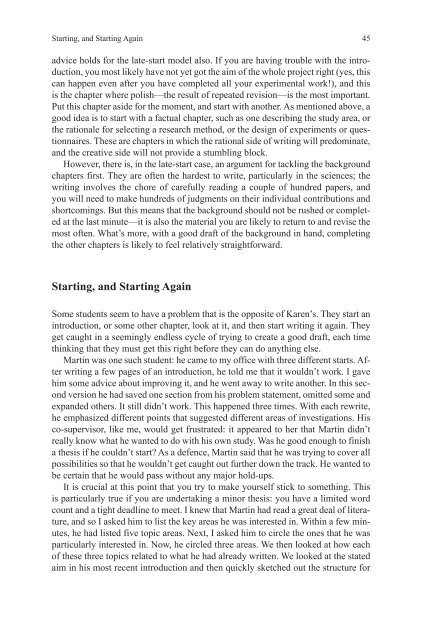How-to-Write-a-Better-Thesis
Create successful ePaper yourself
Turn your PDF publications into a flip-book with our unique Google optimized e-Paper software.
Starting, and Starting Again <br />
45<br />
advice holds for the late-start model also. If you are having trouble with the introduction,<br />
you most likely have not yet got the aim of the whole project right (yes, this<br />
can happen even after you have completed all your experimental work!), and this<br />
is the chapter where polish—the result of repeated revision—is the most important.<br />
Put this chapter aside for the moment, and start with another. As mentioned above, a<br />
good idea is <strong>to</strong> start with a factual chapter, such as one describing the study area, or<br />
the rationale for selecting a research method, or the design of experiments or questionnaires.<br />
These are chapters in which the rational side of writing will predominate,<br />
and the creative side will not provide a stumbling block.<br />
<strong>How</strong>ever, there is, in the late-start case, an argument for tackling the background<br />
chapters first. They are often the hardest <strong>to</strong> write, particularly in the sciences; the<br />
writing involves the chore of carefully reading a couple of hundred papers, and<br />
you will need <strong>to</strong> make hundreds of judgments on their individual contributions and<br />
shortcomings. But this means that the background should not be rushed or completed<br />
at the last minute—it is also the material you are likely <strong>to</strong> return <strong>to</strong> and revise the<br />
most often. What’s more, with a good draft of the background in hand, completing<br />
the other chapters is likely <strong>to</strong> feel relatively straightforward.<br />
Starting, and Starting Again<br />
Some students seem <strong>to</strong> have a problem that is the opposite of Karen’s. They start an<br />
introduction, or some other chapter, look at it, and then start writing it again. They<br />
get caught in a seemingly endless cycle of trying <strong>to</strong> create a good draft, each time<br />
thinking that they must get this right before they can do anything else.<br />
Martin was one such student: he came <strong>to</strong> my office with three different starts. After<br />
writing a few pages of an introduction, he <strong>to</strong>ld me that it wouldn’t work. I gave<br />
him some advice about improving it, and he went away <strong>to</strong> write another. In this second<br />
version he had saved one section from his problem statement, omitted some and<br />
expanded others. It still didn’t work. This happened three times. With each rewrite,<br />
he emphasized different points that suggested different areas of investigations. His<br />
co-supervisor, like me, would get frustrated: it appeared <strong>to</strong> her that Martin didn’t<br />
really know what he wanted <strong>to</strong> do with his own study. Was he good enough <strong>to</strong> finish<br />
a thesis if he couldn’t start? As a defence, Martin said that he was trying <strong>to</strong> cover all<br />
possibilities so that he wouldn’t get caught out further down the track. He wanted <strong>to</strong><br />
be certain that he would pass without any major hold-ups.<br />
It is crucial at this point that you try <strong>to</strong> make yourself stick <strong>to</strong> something. This<br />
is particularly true if you are undertaking a minor thesis: you have a limited word<br />
count and a tight deadline <strong>to</strong> meet. I knew that Martin had read a great deal of literature,<br />
and so I asked him <strong>to</strong> list the key areas he was interested in. Within a few minutes,<br />
he had listed five <strong>to</strong>pic areas. Next, I asked him <strong>to</strong> circle the ones that he was<br />
particularly interested in. Now, he circled three areas. We then looked at how each<br />
of these three <strong>to</strong>pics related <strong>to</strong> what he had already written. We looked at the stated<br />
aim in his most recent introduction and then quickly sketched out the structure for














![[Lonely Planet] Sri Lanka](https://img.yumpu.com/59845622/1/169x260/lonely-planet-sri-lanka.jpg?quality=85)


